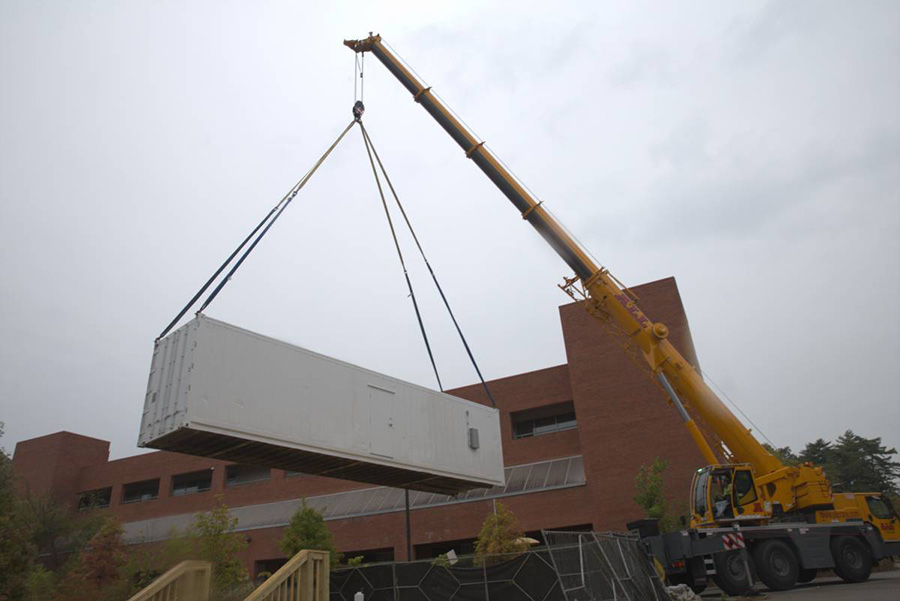 |
| A shipping container, seen here arriving on campus, will eventually grow produce as part of Professor Yongsheng Chen's pilot project for wastewater treatment. Photo: Candler Hobbs |
By Janat Batra
College of Engineering
Every day, an estimated 34 billion gallons of wastewater is processed in treatment facilities across the country, according to the EPA. Now, some of that wastewater will be treated right on campus next to the Center Street Apartments and eventually used to grow fresh produce.
In 2018, Yongsheng Chen, professor in the School of Civil and Environmental Engineering, and his research team received a $5 million grant from the USDA to create a pilot project for wastewater treatment.
The most recent progression of Chen’s pilot project is the implementation of two shipping containers on campus next to the Center Street Apartments, which arrived last month. One container will act as a wastewater treatment facility, and the second will host a mini-farm that the team will use to grow lettuce with the newly treated water.
Abigail Cohen, an environmental engineering Ph.D. student, is a graduate research assistant on Chen’s team who oversaw the arrival of these retrofitted laboratories on campus. Cohen explained how the new treatment facility and mini-farm are bringing the team closer to their ultimate goal with the pilot project.
“We want to move away from conventional fertilizer inputs for agriculture and wastewater treatment, as well as reduce the amount of energy and environmental impact that goes into farming and create a more circular sanitation food process,” said Cohen.
Currently, conventional wastewater treatments use the method of aerobic digestion, meaning that large amounts of air are pumped into big water tanks to push out the solids and organic matter in the water. This aerobic method not only requires high amounts of energy, but it also creates high amounts of sludge from the waste, which is often incinerated or dumped into landfills.
In comparison, Chen’s team plans on using an anaerobic membrane biological treatment to break down the organic matter in wastewater. The amount of biomass that is generated from an anaerobic digestion process is 90 percent less than aerobic, meaning it will result in a smaller footprint in waste generation.
The team, which includes 12 undergrads, nine grad students and three post-docs, is also trying to address eutrophication – the process of fertilizer entering marine ecosystems whether through agricultural runoff, dumping from wastewater facilities, or other means.
The combination of eutrophication, wastewater treatment and artificial intensive agriculture leads to major burden on the ecosystem. The team hopes that in the long run, the pilot will have far-reaching impacts on natural ecosystems, However, their present focus is on getting the two new containers operating.
Although these containers will primarily serve as the laboratories where the pilot research will be conducted, the facilities themselves are a cutting-edge display of technology as they represent how wastewater treatment can be conducted at a local, sustainable level rather than having to be transported to larger, pollution producing facilities.
For now, the lettuce produced using this anaerobic process will be treated as bio-hazard material and discarded. As the pilot project continues to progress, the team aims to eventually grow produce that is up to FDA standards for consumption.
The large interdisciplinary team working on the project speaks to the wide range of engineering and public policy needed to address sustainability issues, particularly when it comes to waste water treatment. In addition to the USDA grant, the pilot project has received significant funding from Georgia Tech for facilities and build field sites.
“This type of collaborative research sets Georgia Tech apart as a leading research institution,” said Chen. “With this pilot project, we are committed to creating a more resilient and sustainable society, while at the same time revolutionizing engineering education to train future generations on agricultural technology.”
